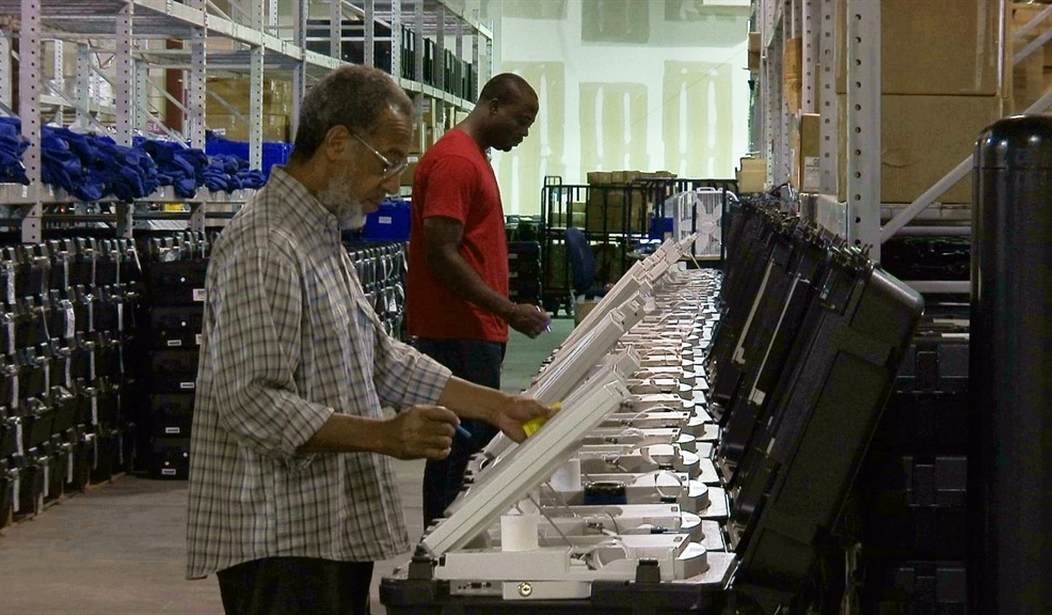Sometime the Luddites have a point. After the infamous controversy over punch ballots in Florida during the Bush-Gore recount fight in the 2000 election, voters demanded more reliable and updated technology for election infrastructure. Electronic voting looked like the wave of the future, and states and counties enthusiastically adopted paperless voting systems. Thanks to a number of concerns since their widespread use, especially about security in an age of hacking, one large Texas county has decided to buck the trend and go back to paper ballots:
The unusual move sets Denton, the ninth-largest county in Texas and one of the fastest-growing, apart from the state’s other biggest counties, which all use some form of electronic voting, according to data collected by the Secretary of State’s office. Both Bexar and Harris Counties, for example, have had all electronic voting systems in place for 15 years.
Denton has been using a hybrid voting system that employs both electronic and paper ballots for about a decade. But county officials recently approved spending just shy of $9 million to buy new voting equipment from Austin-based Hart InterCivic that will return to an entirely paper-based system in time for this year’s November elections. Even disabled voters, who will cast their votes on touch-screen machines, will have their ballots printed out and tallied through a print scanner.
The catalyst in Denton wasn’t security as much as it was operational issues:
The move comes months after a disastrous election day for Denton County in November, with machines inadvertently set to “test mode” instead of “election mode,” long lines, problems with scanning paper ballots, and, ultimately, incorrect tabulations. Phillips — who was working in nearby Tarrant County at the time — said it was the personnel, not the machines, that caused chaos last fall. But voters in town, as well as leaders with the local Democratic and Republican parties, called for a return to paper ballots in the months following election day.
“The question always comes: ‘How do I know that when I cast my ballot it’s recorded electronically?’” Phillips said. “We know it’s recorded correctly because of our testing methods, but that question has persisted ever since we started using electronic voting. With the political climate these days, it’s even more heightened right now.”
Both issues highlight why the stampede to all-electronic balloting was a mistake from the start. The voting process — the actual casting of the vote, along with the tabulation afterward — has to have some sustainability and accountability built into it, as well as minimize the issues surrounding human error. Thus far, electronic-only balloting fails on all of these issues. It’s usually more complicated to use, especially for older voters, which was a key complaint of the butterfly ballots in 2000 (despite having been in broad use for decades). Technical issues can hamper the vote-casting process, leading to huge delays that could conceivably discourage people from voting on Election Day. Paper ballots are not just easier to use, but also do not rely on electronic platforms that can fail or delay the vote-casting process.
The biggest problems with all-electronic voting systems arise after the vote-casting process. Security issues are the rage at the moment, but hacking is at best a local risk; without a nationwide network of machines, hackers would have to hit machines in separate precincts to manipulate an election above the local level. Glenn Reynolds wrote two weeks ago, though, that the security risks still need to be taken seriously, and he’s correct:
In some ways, paper and ink is a super technology. When you cast a vote on a voting machine, all that’s recorded is who you voted for. But a paper ballot captures lots of other information: Ink color, handwriting, etc. If you have access to a voting machine that’s connected to the Internet, you can change all the votes at once. To change a bunch of paper ballots takes physical access, and unless you’re very careful the changed ballots will show evidence of tampering. Paper ballots aren’t fraud-proof, of course, as a century of Chicago politics demonstrates, but they’re beyond the reach of some guy sitting at a computer in a basement halfway around the world. And there are well-known steps to make Chicago-style fraud harder.
Paper ballots that use fill-in bubbles might have a small amount of potential for voter error, but they do not deteriorate over time, and can easily be reviewed and recounted by hand to validate the final results. Optical-scan paper ballots can be easily tabulated in the precincts with high confidence in reliability, while leaving open the option for hand-counting if the reliability is questioned. And these optical-scan ballots can be checked by the voter to ensure that it reads correctly before filing the ballot with the precinct officials, which allows the voter to start over again if necessary.
Furthermore, Denton’s new system solves another problem: the lack of printed official ballots. It prints ballots on demand in case of surprising voter turnout, and thus makes it unnecessary to have a large number of uncast ballots laying around at the risk of malice. That provides all of the adaptability of electronic balloting with none of its risks.
Over the past two decades, we prioritized technology over needs in search of a solution. It’s far past time to return to a needs-based approach, and electronic-only balloting fails. Denton County may be one of the first to realize that, but the rest of the nation needs to pay close attention.








Join the conversation as a VIP Member